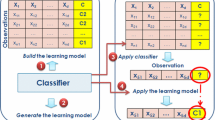Abstract
A new immune-inspired model of the fuzzy dendritic cell method is proposed in this paper. Our model is based on the function of dendritic cells within the framework of fuzzy set theory and fuzzy c-means clustering. Our purpose is to use fuzzy set theory to smooth the crisp separation between DCs’ contexts (semi-mature and mature) since we can neither identify a clear boundary between them nor quantify exactly what is meant by “semi-mature” or “mature”. In addition, we aim at generating automatically the extents and midpoints of the membership functions which describe the variables of the model using fuzzy c-means clustering. Hence, we can avoid negative influence on the results when an ordinary user introduces such parameters. Simulations on binary classification databases show that by alleviating the crisp separation between the two contexts and generating automatically the extents of the membership functions, our method produces more accurate results.
Access this chapter
Tax calculation will be finalised at checkout
Purchases are for personal use only
Preview
Unable to display preview. Download preview PDF.
Similar content being viewed by others
References
Greensmith, J.: The Dendritic Cell Algorithm. PhD Thesis, University of Nottingham (2007)
Greensmith, J., Aickelin, U., Cayzer, S.: Introducing dendritic cells as a novel immune-inspired algorithm for anomaly detection. In: Jacob, C., Pilat, M.L., Bentley, P.J., Timmis, J.I. (eds.) ICARIS 2005. LNCS, vol. 3627, pp. 153–167. Springer, Heidelberg (2005)
Aickelin, U., Greensmith, J.: The Deterministic Dendritic Cell Algorithm. In: 7th International Conference on Artificial Immune Systems, Phuket, hailand, pp. 291–302 (2008)
Chelly, Z., Elouedi, Z.: FDCM: A fuzzy dendritic cell method. In: Hart, E., McEwan, C., Timmis, J., Hone, A. (eds.) ICARIS 2010. LNCS, vol. 6209, pp. 102–115. Springer, Heidelberg (2010)
Basbuska, R.: Fuzzy modeling for control. Kluwer Academic Publishers, Boston (1998)
Zadeh, L.: Fuzzy Sets. Information and Control 8, 338–353 (1965)
Zimmermann, J.: Fuzzy Set Theory and Its Applications. European Journal of Operational Research 1, 227–228 (1996)
Zadeh, L.: The Concept of a Linguistic Variable and its Application to Approximate Reasoning I. Information Sciences 8, 199–251 (1975)
Ishibuchi, H., Nakashima, T.: Effect of rule weights in fuzzy rule-based classification systems. IEEE Transactions on Fuzzy Systems 9, 506–515 (2001)
Mamdani, H., Assilian, S.: An experiment in linguistic synthesis with a fuzzy logic controller. International Journal of Man-Machine Studies 7, 1–13 (1975)
Mizumoto, M.: Fuzzy controls by product-sum gravity-method. Fuzzy Sets and Systems, c1.1–c1.4 (1990)
Lee, C.: Fuzzy logic in control systems: Fuzzy logic controller - Parts 1 and 2. IEEE Transactions on Systems, Man and Cybernetics 2, 404–435 (1990)
Broekhoven, E., Baets, D.: Fast and accurate center of gravity defuzzification of fuzzy system outputs defined on trapezoidal fuzzy partitions. Fuzzy Sets and Systems 157, 904–918 (2006)
Bezdek, J.: Pattern Recognition with Fuzzy Objective Function Algorithms. Plenum Press, New York (1981)
UCI machine learning repository, http://archive.ics.uci.edu
Author information
Authors and Affiliations
Editor information
Editors and Affiliations
Rights and permissions
Copyright information
© 2011 Springer-Verlag Berlin Heidelberg
About this paper
Cite this paper
Chelly, Z., Elouedi, Z. (2011). Further Exploration of the Fuzzy Dendritic Cell Method. In: Liò, P., Nicosia, G., Stibor, T. (eds) Artificial Immune Systems. ICARIS 2011. Lecture Notes in Computer Science, vol 6825. Springer, Berlin, Heidelberg. https://doi.org/10.1007/978-3-642-22371-6_36
Download citation
DOI: https://doi.org/10.1007/978-3-642-22371-6_36
Publisher Name: Springer, Berlin, Heidelberg
Print ISBN: 978-3-642-22370-9
Online ISBN: 978-3-642-22371-6
eBook Packages: Computer ScienceComputer Science (R0)




